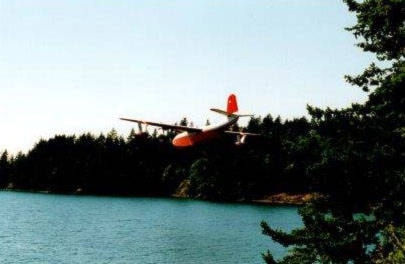Elida Peers | Contributed
It seems strange that we’re talking about wildfires already, but that seems to be what’s in the wind.
Swooping down to scoop up water from the eastern end of Sooke Basin, this Martin Mars was a pretty exciting sight as the four-engine bomber would scoop up water, 30 tons in 26 seconds, heading off to put out a wildfire in the hills.
Back in the 1980s, Joe Titus captured this shot from his waterfront home on Gillespie Road, near Grouse Nest.
The Martin Mars waterbombers were a fixture of British Columbia’s summer seasons for nearly half a century. Six of the huge amphibious planes were produced for the U.S. Navy during the 1940s. Their working lives were seemingly short-lived in the 1950s when a group made a bold decision of forestry firms in British Columbia to repurpose the tankers.
Several forestry giants, including McMillan Bloedel and B.C. Forest Products, banded together to form Forest Industry Flying Tankers, bought the four flying boats that were still operational and brought them to Victoria for conversion into waterbombers to protect B.C. forests. Their tanks could hold 6,000 Imperial gallons of water, and fire retardant chemicals could be added.
The Forest Industry Flying Tankers fleet was established at Sproat Lake near Port Alberni in the early 1960s.
Bruce Payne, a pilot well known to many in Sooke, flew for the firefighting group for 17 years and recalled that the mighty Mars burned up 500 gallons of fuel per hour. While Payne generally flew one of the four helicopters in the fleet, he also took flights on Mars.
While one of the Mars crashed near Parksville, and one was damaged while parked during a storm, the two remaining continued to fight fires up into the 21st century. While no longer operational today, the two planes might be considered museum pieces as they rest in retirement at Sproat Lake.
While fixed-wing aircraft of different makes, plus helicopters, continue to protect B.C.’s forests nowadays, they are more likely to use chemical retardants than scooping up water. Longtimers in Sooke have had several opportunities to view the historic Martin Mars scooping water in the Sooke Basin.
•••
Elida Peers is the historian of the Sooke Region Museum.
editor@sookenewsmirror.com
Like us on Facebook and follow us on Twitter
